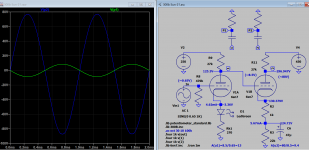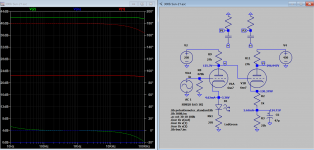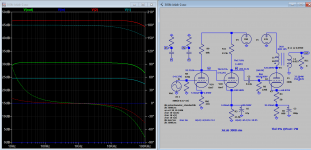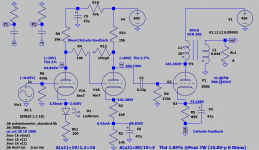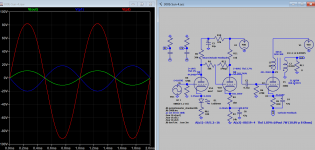Hello to the community. The thing is- i have lundahll 1664 transformers se with 100 ma. I’m about to build se amp based on these transformers. They suit for both 2a3 and 300b. Currently i keep an eye on sun audio schematic as the standard one. Would anybody suggest better schematic for my needs? I’ve already simulated everything in orcad pspice and everything goes ok, ready to build pcbs. But.. maybe there is a more decent application? Your suggestions are highly appreciated.
How did a schematic from a 1980s Japanese amp become a standard? At the time it was great for Japanese audiophiles with efficient speakers in tiny rooms. Today there are many better alternatives, particularly for a 300B amplifier. Have you done any searches on DiyAudio for single ended 2A3 or 300B amps?
With a 2Vrms standard output for a DAC or CD player, there is little reason to resort to a three stage amp like the Sun. There are a plethora of candidates to drive the 2A3/300B, but if you are in Russia, the 6S4P-E 6С4П-Е would be a natural choice. The US/Europe equivalent is the EC86.
So consult the tube manual for the operating points for the 2A3 or 300B and that gives you your power supply requirements and allows you to design the power supply.
Check the tube manual for the EC86/6S4P operating points. Connect the two tubes with a good cap and grid resistor for the 2A3/300B; add a volume control and you are there.
With a 2Vrms standard output for a DAC or CD player, there is little reason to resort to a three stage amp like the Sun. There are a plethora of candidates to drive the 2A3/300B, but if you are in Russia, the 6S4P-E 6С4П-Е would be a natural choice. The US/Europe equivalent is the EC86.
So consult the tube manual for the operating points for the 2A3 or 300B and that gives you your power supply requirements and allows you to design the power supply.
Check the tube manual for the EC86/6S4P operating points. Connect the two tubes with a good cap and grid resistor for the 2A3/300B; add a volume control and you are there.
Maybe choosing the 6S4P-E is just a bit better than choosing the EC86. At the same anode voltages and anode currents, the 6S4P requires a bit more bias than the EC86 (the difference lies between about 0.5 V and 1 V, depending on the chosen operating point). That difference makes it a bit easier to choose a good operating point while keeping the bias high enough to prevent grid current at positive going parts of large input signals (according to the datasheet for the 6S4P-EB grid current can start at -1.1 V).
I wouldn't go with russian tubes as it is hard to get them. i'd like to use something like 6SL7, 6SN7 or other modern ones. Would you please point out some good and approved schematics of similar projects as there are tons of designs, but may be there are some "classic" projects
I would highly suggest NOT using that design.
I just went down that path, against the advice of some people here, and ended up redesigning the front end of that amp into a cascode design after I built it, due to the very poor performance of that direct coupled 6SN7 design. It seems this design somehow it sims like it should work well, but in practice it doesn't. Unless of course you only need 1W of power, which in that case, why are you building a 300B amp?
I did a video series about this, and also about rebuilding the Boyuurange A50 that uses this Sun Audio design, into the cascode type and doubled the power output and massively lowered the distortion.
This is a single video explaining the problems with that design.
300B Tube Amp: Final Analysis, Mods and Solutions for JC Morrison based Amplifiers. - YouTube
Here is a direct test of that direct coupled design to the cascode.
Boyuurange / Reisong A50 300B Tube Amp Advanced Mods Part Three - YouTube
Here are two multi video playlists that show two different "Sun Audio/JC Morrison" designed amps that are transformed using my cascode design.
300B DIY Budget Tube Amplifier Build Series - YouTube
Boyuurange A50 300B Tube Amplifier - YouTube
And last, here is the schematic and the BOM I ended up as the final for my DIY 300B build using a pair of 6SN7 drivers. Feel free to use this, it works pretty decent. And also, I tested this and it sounds nice using 6H8C tubes in place of the 6SN7 tubes.
Skunkie Designs 300B
If I was starting from scratch and was open to considering other tubes to use to drive a 300B, I would look at some different pentode front ends. Even a 6EJ7 or a 6JC6A would likely do a better job than making a virtual pentode out of a 6SN7 pair.
You need at least 140V of swing, preferably 160V that is capable of doing this into the load the grid of a 300B presents, with it's 250k grid leak resistor requirement. That Sun Audio design shared around the web doesn't even come close to doing that. A much cheaper and easier to design amp, that likely would sound as good or maybe even better, would be to design something around an EL34 or a KT88 output tube.
I just went down that path, against the advice of some people here, and ended up redesigning the front end of that amp into a cascode design after I built it, due to the very poor performance of that direct coupled 6SN7 design. It seems this design somehow it sims like it should work well, but in practice it doesn't. Unless of course you only need 1W of power, which in that case, why are you building a 300B amp?
I did a video series about this, and also about rebuilding the Boyuurange A50 that uses this Sun Audio design, into the cascode type and doubled the power output and massively lowered the distortion.
This is a single video explaining the problems with that design.
300B Tube Amp: Final Analysis, Mods and Solutions for JC Morrison based Amplifiers. - YouTube
Here is a direct test of that direct coupled design to the cascode.
Boyuurange / Reisong A50 300B Tube Amp Advanced Mods Part Three - YouTube
Here are two multi video playlists that show two different "Sun Audio/JC Morrison" designed amps that are transformed using my cascode design.
300B DIY Budget Tube Amplifier Build Series - YouTube
Boyuurange A50 300B Tube Amplifier - YouTube
And last, here is the schematic and the BOM I ended up as the final for my DIY 300B build using a pair of 6SN7 drivers. Feel free to use this, it works pretty decent. And also, I tested this and it sounds nice using 6H8C tubes in place of the 6SN7 tubes.
Skunkie Designs 300B
If I was starting from scratch and was open to considering other tubes to use to drive a 300B, I would look at some different pentode front ends. Even a 6EJ7 or a 6JC6A would likely do a better job than making a virtual pentode out of a 6SN7 pair.
You need at least 140V of swing, preferably 160V that is capable of doing this into the load the grid of a 300B presents, with it's 250k grid leak resistor requirement. That Sun Audio design shared around the web doesn't even come close to doing that. A much cheaper and easier to design amp, that likely would sound as good or maybe even better, would be to design something around an EL34 or a KT88 output tube.
Last edited:
The problem mainly lies in 2nd stage as with the plate supply of 280V?), the tube is bias too low (< 2V?) to get higher voltage than < 60V to drive 300b to full output. It may sound good at lower output as also the not very linear driver output is a kind of pre-distortion correction for 300b to give a reasonable sound output. In order to improve the driver output comparable to cascode stage much changes are required as attached. 2nd plate supply voltage must be increased and local degeneration feedback is used to increase headroom with overdrive (the stage can take more drive than tube bias because of cathode degeneration).
Attachments
The problem mainly lies in 2nd stage as with the plate supply of 280V?), the tube is bias too low (< 2V?) to get higher voltage than < 60V to drive 300b to full output. It may sound good at lower output as also the not very linear driver output is a kind of pre-distortion correction for 300b to give a reasonable sound output. In order to improve the driver output comparable to cascode stage much changes are required as attached. 2nd plate supply voltage must be increased and local degeneration feedback is used to increase headroom with overdrive (the stage can take more drive than tube bias because of cathode degeneration).
Even with the plate load resistor supply voltage increased a bunch (to just over 400V), it then had the voltage swing (150V) but the signal at the grid of the 300B was all kinds of distorted. It would only work if you were OK listening to 8%+ distortion.
I played around some more but just gave up after seeing how good the cascode performs. Someone else simed changes they promised would fix it earlier, when I hard wired those changes, it was a hot mess that had less drive that the stock setup. Sorry but I just don't trust some of these simulated designs to work when put into the actual amp.
I'm curious as to why the distortion is so high, my sim has 3% distortion @160Vp-p, drive current >5mA. Taken pre-distortion correction into account and sufficient current drive gives low 1.5%Thd @Pout 7W. (Maybe you can let me know where I can find the mod sch you mentioned?). I used cascode for my OTL amp, distortion or whatever is close to sim prediction. I have model > 100 tube model so far, none were reported far from actual, except maybe the grid current where I don't have the data. See if anything I can help beside this particular cascade, or how good your cascode sch is?
ps Btw I have link where this person started to build the Sun amp see how close his comment is to my comment earlier. It was ? 10 years ago someone realized there is problem need fixing but do you find any until now?
DIY Audio Projects Forum • First DIY amp FINISHED - 300B SET - works!
ps Btw I have link where this person started to build the Sun amp see how close his comment is to my comment earlier. It was ? 10 years ago someone realized there is problem need fixing but do you find any until now?
DIY Audio Projects Forum • First DIY amp FINISHED - 300B SET - works!
Last edited:
I'm curious as to why the distortion is so high, my sim has 3% distortion @160Vp-p, drive current >5mA.
No idea but I built it and measured. You could see the distortion on an analog scope at the 300B grid. There was another thread recently where someone was saying their 300B amp calculated to 2% distortion, when they built it, it was 10%.
That shouldn't be a good reason not to trust simulation, just trash in=trash out. I think incorrect sim can be disappointing sometimes, but good if done correctly, it's also a good tool to verify other people work before building it, thank you.
As for sharing here Jelabs 300B simulation. Note how close the operations points of actual amp and sim are. Thd% in each stage should be accurate. In the sch, Thd @2nd stage is >7% hence the Thd of output load is >4%. due to too much in per-distortion correction, IMO.
Toasted my rectifier - need some pointers to troubleshoot
Toasted my rectifier - need some pointers to troubleshoot
Attachments
Last edited:
Ok, i’ve got the point. Stephe, i watched your video with research and tweaks. Seems like the circuit is far from being perfect. Could someone propose a well designed and approved schematic for 300b or 2a3. Complexity doesn’t matter
Sun SV-300BSE Details:
Power Transformer: Tamura SPT150
Choke coil: Tamura SCH515
Output Transformer: Tamura SOT525
Push tube: PHILIPS 6SN7 85 new
Power tube: CR 300B (Japanese aging matching) 85 new, 58mA@270V screen voltage
Rectifier: American JAN 5R4
Main filter capacitor Authentic Nissan ELNA CERAFINE 47+47UF/500V
Power Transformer: Tamura SPT150
Choke coil: Tamura SCH515
Output Transformer: Tamura SOT525
Push tube: PHILIPS 6SN7 85 new
Power tube: CR 300B (Japanese aging matching) 85 new, 58mA@270V screen voltage
Rectifier: American JAN 5R4
Main filter capacitor Authentic Nissan ELNA CERAFINE 47+47UF/500V
Improved cascade version using Schade and Cathode Feedback for sharing, welcome any comment or mods, if no comment I''ll stop here.
Attachments
Last edited:
Ok, i’ve got the point. Stephe, i watched your video with research and tweaks.
I just didn't want you to repeat the mistakes I made. Honestly, I think there are probably better tubes for driving a 300B than a 6SN7, it was just my goal to build an amp using them because: I like octal socket tubes, have a bunch of them and wanted an amp to use them on.
I personally would be looking for something that has been built and the owners like the way it sounds. There is more to what an amp sounds like than can be seen in electrically measuring it. I know that "Blueglow" KT88 amp sounds really good, unless you are fixated on using a DHT.
Good luck!
1664 gapped for 100mA - I would give the idea that JC Morrison proposes here a try on a breadboard. You can use a lower current tube like the 2a3 and still get the rated current through the small transformer which I think would pay in sound benefits.
Breadboards are easy, I frankly don't understand why people move so quickly to finished builds.
=2¢
Breadboards are easy, I frankly don't understand why people move so quickly to finished builds.
=2¢
I think there are probably better tubes for driving a 300B than a 6SN7, it was just my goal to build an amp using them because: I like octal socket tubes,
If you want a good driver for a 300B that is an octal, plentiful, and cheap then use the 6K5. There is a discussion about this over on AudioKarma.
Thank you stephe, hearinspace and palustris for your help. I’m looking for some classical design. Maybe some kind of Thorsten designs or reichert 300b. By the way what are the sonic difference between 2a3 and 300b? My speakers are 95 db, currently driven by Aleph j.
OK, you want what you want and who's to argue with that.
Unless you enhance it in something like in the JC circuit don't even think about the 2a3. It's way too much of a backward step powerwise from your Aleph.
It sounds like you've already read about Thorsten's Legacy amplifier. So here's a link to a thread on the Audio Asylum that, a little farther down the page has a bit about the Western Electric 91 and Paul Joppa's parafeed version of Joe Roberts' redux. (The TFA-2004 output transformer is 3KΩ)
You should also have a look at the Komuro 300b. Much more in a Google search .
Unless you enhance it in something like in the JC circuit don't even think about the 2a3. It's way too much of a backward step powerwise from your Aleph.
It sounds like you've already read about Thorsten's Legacy amplifier. So here's a link to a thread on the Audio Asylum that, a little farther down the page has a bit about the Western Electric 91 and Paul Joppa's parafeed version of Joe Roberts' redux. (The TFA-2004 output transformer is 3KΩ)
You should also have a look at the Komuro 300b. Much more in a Google search .
- Home
- Amplifiers
- Tubes / Valves
- Advice for lundahll 1664 se amp
